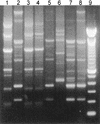Persistence of Lactobacillus fermentum RC-14 and Lactobacillus rhamnosus GR-1 but not L. rhamnosus GG in the human vagina as demonstrated by randomly amplified polymorphic DNA
- PMID: 11777835
- PMCID: PMC119863
- DOI: 10.1128/cdli.9.1.92-96.2002
Persistence of Lactobacillus fermentum RC-14 and Lactobacillus rhamnosus GR-1 but not L. rhamnosus GG in the human vagina as demonstrated by randomly amplified polymorphic DNA
Abstract
Lactobacillus rhamnosus GR-1 and L. fermentum RC-14 are well-characterized probiotic strains with efficacy in the prevention and treatment of urogenital infections in women. The aim of the present study was to apply a molecular biology-based methodology for the detection of these strains and L. rhamnosus GG (a commercially available intestinal probiotic) in the human vagina in order to assess probiotic persistence at this site. Ten healthy women inserted vaginally a capsule containing either a combination of strains GR-1 and RC-14 or the GG strain for 3 consecutive nights. Vaginal swabs taken before and at various time points after probiotic insertion were analyzed, and the Lactobacillus flora was assessed by randomly amplified polymorphic DNA (RAPD) analysis. This method generated discrete DNA fingerprints for GR-1, RC-14, and GG and enabled successful detection of these strains in the vagina. Strain GR-1 and/or strain RC-14 was found to persist in the vaginal tract for up to 19 days after vaginal instillation, while L. rhamnosus GG was detectable for up to 5 days postadministration. In conclusion, the fates of probiotic L. rhamnosus and L. fermentum strains were successfully monitored in the human vagina by RAPD analysis. This technique provides molecular biology-based evidence that RC-14 and GR-1, strains selected as urogenital probiotics, persist in the human vagina and may be more suited to vaginal colonization than L. rhamnosus GG. This highlights the importance of proper selection of strains for urogenital probiotic applications.
Figures




References
-
- Antonio, M. A. D., S. E. Hawes, and S. L. Hillier. 1999. The identification of vaginal Lactobacillus species by the demographic and microbiologic characteristics of women colonized by these species. J. Infect. Dis. 180:1950–1956. - PubMed
-
- Barbes, C., and S. Boris. 1999. Potential role of lactobacilli as prophylactic agents against genital pathogens. AIDS Patient Care STDS 13:747–751. - PubMed
-
- Brennan, N. M., R. Brown, M. Goodfellow, A. C. Ward, T. P. Beresford, P. J. Simpson, P. F. Fox, and T. M. Cogan. 2001. Corynebacterium mooreparkense sp. nov. and Corynebacterium casei sp. nov., isolated from the surface of a smear-ripened cheese. Int. J. Syst. E vol. Microbiol. 51:843–852. - PubMed
-
- Bruce, A. W., and G. Reid. 1988. Intravaginal instillation of lactobacilli for prevention of recurrent urinary tract infections. Can. J. Microbiol. 34:339–343. - PubMed
-
- Bruce, A. W., G. Reid, J. A. McGroarty, M. Taylor, and C. Preston. 1992. Preliminary study on the prevention of recurrent urinary tract infections in ten adult women using intravaginal lactobacilli. Int. Urogynecol. J. 3:22–25.
MeSH terms
LinkOut - more resources
Full Text Sources
Other Literature Sources

